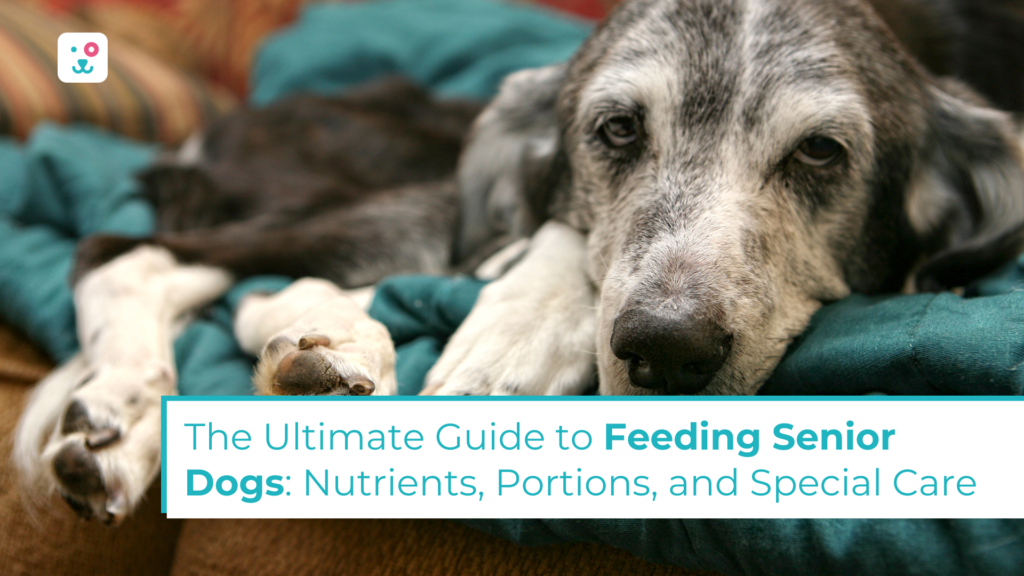Getting older is a part of life, even for canine companions. With age comes new experiences and new needs and sometimes a little extra support. As dogs enter their senior years, their dietary needs change, and it is important for pet owners to adapt to adapt to these changes. By giving them the right nutrition, you can improve their overall health and happiness big time. So if your pup is still full of energy you can go through this guide for future reference. If they’re slowing down, this guide will help you navigate the ins and outs of feeding a senior dog, ensuring they stay strong, healthy, and full of life.
Recognizing When Your Dog is a Senior
Different dog breeds reach their senior years at different times. If you’re seeing signs of aging like lower energy levels, stiffness, or weight changes in your dog, it may be time to adjust their diet to better suit their needs.
Before getting into diet changes, it’s good to know when your dog is considered a senior. This varies by breed and size:
- Small breeds (under 20 lbs) become seniors around 10-12 years old.
- Medium breeds (20-50 lbs) hit senior status around 8-10 years old.
- Large breeds (50+ lbs) are considered seniors as early as 6-8 years old.
Key Nutrients for Senior Dogs
As dogs get older, their metabolism slows down. They may develop health concerns like joint issues, and digestive sensitivities. The right nutrients can help them age gracefully. Here’s what to look for:
1. High-Quality Protein
Protein helps maintain muscle mass which is important for all dogs but especially good for senior dogs. The best proteins for dogs are easily digestible. Look for lean animal proteins like chicken, turkey, fish, and eggs.
2. Healthy Fats for Joint and Brain Health
Older dogs benefit from omega-3 fatty acids, which help support their joints and their brain function. Ingredients like fish oil, flaxseed, and salmon can provide these essential fats.
3. Fiber for Digestion
For some dogs, age also comes with digestive issues. Fiber-rich foods like sweet potatoes, pumpkin, and brown rice can keep their gut healthy and regular.
4. Vitamins and Minerals
- Glucosamine & Chondroitin: Support joint health and mobility.
- Antioxidants (Vitamins C & E): Help reduce inflammation and support the immune system.
- Calcium & Phosphorus: Maintain bone strength and prevent osteoporosis.

How Much Should You Feed a Senior Dog?
Portion control is crucial, as aging dogs are prone to weight gain or loss. Feeding guidelines depend on your dog’s size, activity level, and metabolism.
General Feeding Guidelines by Weight:
Dogs are not the same. Make sure you keep an eye on their body condition—if they start gaining or losing weight, adjust portions accordingly.
- Small dogs (10-20 lbs): ¾ – 1.5 cups per day, split into two meals.
- Medium dogs (20-50 lbs):5 – 3 cups per day, split into two meals.
- Large dogs (50+ lbs): 3 – 4.5 cups per day, split into two meals.
Special Considerations for Senior Dogs
1. Weight Management
Metabolism slows down with age, making weight gain more likely. Choose a low-calorie, high-protein diet to maintain muscle while preventing obesity. If your senior pup is underweight, go for nutrient-dense foods to help them gain weight healthily.
2. Soft or Wet Food for Dental Issues
Many senior dogs experience dental problems, making crunchy kibble difficult to eat. If your pup struggles with chewing, consider switching to soft, wet food or adding warm water or broth to kibble to soften it.
3. Frequent, Smaller Meals
Instead of one or two large meals, feed your senior dog smaller, more frequent meals throughout the day. This helps with digestion and keeps their energy levels stable.
4. Hydration is Key
Older dogs are more prone to dehydration. Make sure your older doggy always has access to fresh, clean water. If your dog isn’t much of a water drinker, you can sneak in their hydration into their food. Incorporate wet food into their diet to help them get more water in.
Transitioning to a Senior Dog Diet
If you’re switching your pup’s diet, make the transition gradually to prevent stomach upset. It’s always important to pay close attention to any digestive changes when dogs’ diets change. Look out for diarrhea or loss of appetite, and adjust as needed.
Follow this schedule:
- Days 1-3: 75% old food, 25% new food
- Days 4-6: 50% old food, 50% new food
- Days 7-9: 25% old food, 75% new food
- Day 10+: 100% new food

Choosing the Best Food for Your Senior Dogs
Not all pet food is created equal, so choose brands that prioritize real, whole ingredients without fillers or artificial additives.
For those looking for high-quality, nutritious meals designed for dogs of all ages, California Dog Kitchen offers fresh, wholesome options that support senior dog health. Their meals are crafted with real meats, fresh veggies, and essential nutrients, ensuring your pup gets the best possible care.
Also Read: 5 Best Indoor Exercises for Senior Dogs to Stay Fit
Final Thoughts: Making Your Senior Dog’s Golden Years the Best Yet
Feeding your senior dog a balanced, nutrient-rich diet is one of the best ways to support their health and longevity. With the right portions, high-quality ingredients, and a little extra love, you can keep your furry companion happy, healthy, and thriving for years to come.
Every dog deserves to enjoy their golden years with good food, plenty of belly rubs, and all the tail wags. So, here’s to keeping our senior pups well-fed, well-loved, and forever young at heart!

